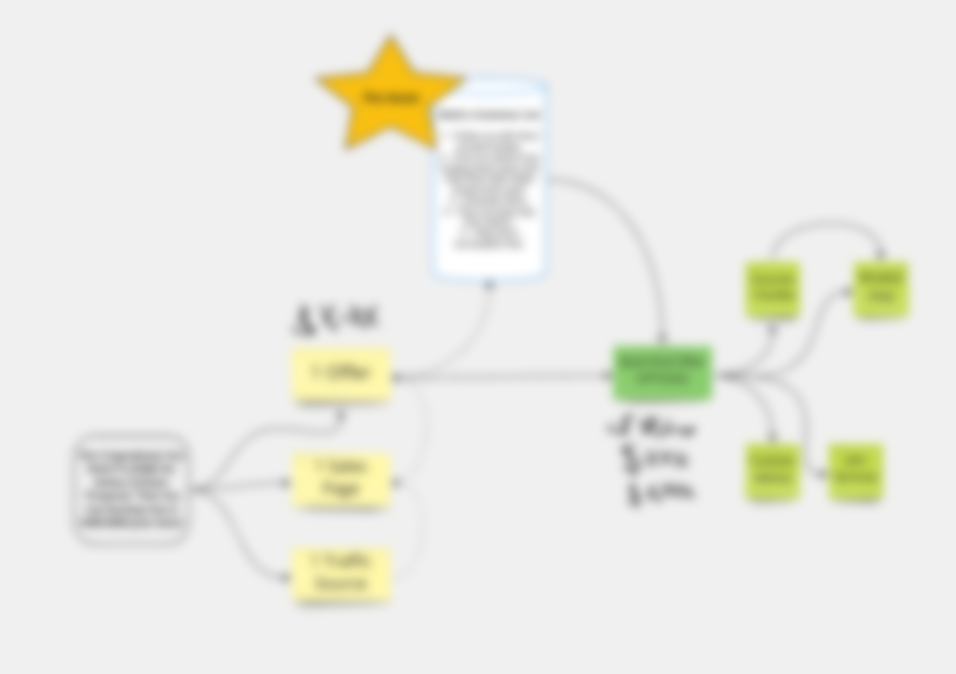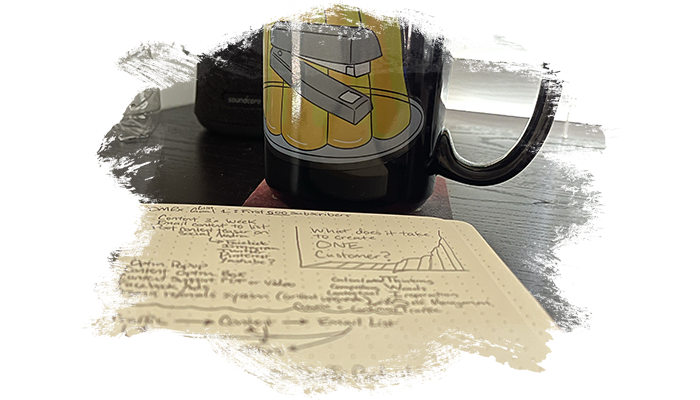A large part of your success in the digital product business comes down to choosing a good market.
I define a market as…
People who share a common desire.
Desire is defined as a strong feeling of want or need that someone has.
These desires shape the behavior of individuals and of the group of individuals who share the common desire. Some of these desires are so strong that you can’t ignore them. For example, the desire to eat when you are hungry, the desire to be warm when you are freezing cold, or the desire to cool down when you are too hot.
There’s a few things to understand about desires…
1 – Desires already exist, you cannot create desire.
2 – You can channel someone’s (or a group’s) desire into wanting your product, but you cannot create that desire in the first place.
3 – Desires come in varying degrees of “strength” or said a different way, varying levels of power over an individual’s or groups’ behavior.
Because of this, the market you choose to be “in”, or rather the “desire” you wish to help people with is such an important decision.
Even with everything else remaining equal, two quality products, both with great marketing, great branding, and great timing…
You can see huge differences in sales volume (number of sales), value of each individual sale, and the frequency at which the customers come back and buy other products from you.
For example, in the “weight loss” market, someone with a quality product could easily make thousands of dollars per month while someone with an equally ‘good’ product in the “underwater sculpture painting” market could struggle to make even a few hundred dollars per month.
There are multiple reasons why this is.
How is it that two different markets can produce such different results regardless of the product quality & marketing efforts put forth?
Here are three characteristics of markets that may have an impact on your results regardless of the quality of your product, your skill at marketing, or any other efforts you put in.
Characteristic of a Good Market #1 – Size of the Market
This is the number of potential customers for your products.
Larger markets have more potential buyers. Smaller markets have fewer potential buyers.
Think tiny streams vs rivers vs oceans.
Here are the upsides and downsides to smaller vs larger market sizes.
Larger markets tend to be easier to reach with your marketing because they tend to be everywhere. This means that you can usually find this market hanging out on Facebook, Google, and several different websites online. This gives you the advantage of using several different traffic sources (i.e. places to get web-visitors from) to get customers for your digital products.
With larger markets you also have the ability to reach new people every day so you can potentially run the same digital product offer successfully for years without making big updates or adjustments to it.
A larger market also has some downsides.
Due to the large size of the market, the people within it will have different motivations and will require different marketing messages to effectively reach them AND get them to consider purchasing your digital product.
For example, in the weight loss market, you have some people that want to lose the last 5-10 lbs. Others want to lose 20-30 lbs. And others want to lose over 50+ lbs or more. Then you have different genders, different age groups, different health conditions, different reasons for wanting to lose weight, different ways in how they want to lose weight (pills vs diets vs exercise vs surgery vs other) etc.
Each of those groups will need to be spoken to differently and each of those different ‘messages’ takes extra time to create.
You also tend to have more competitors in a larger market than in a smaller market. This can be both an upside and a downside. This is because in a larger market there are more people with money to spend and this creates room for more competitors to enter the market and sell their products.
With a smaller sized market, you have fewer sub-groups to cater to and this keeps you from spreading your efforts too thin trying to market to multiple sub-groups. Instead, you can focus your time on dialing-in one message which helps you maximize your results faster.
The downside in a smaller sized market is that you naturally have fewer overall potential customers. If the market is too small it may not be able to support your business goals. In other words, there may not be enough money to go around.
With a smaller sized market you also run into something called “offer fatigue” much faster and have to update or change your offer often to keep making sales of your digital product. Offer fatigue does not prevent you from selling your product successfully for years. It simply means you’ll probably have to invest more time into updating your marketing often to avoid ad blindness.
Characteristic of a Good Market #2 – Existing Competition
If you have multiple competitors in a given market, it means you’ll have to work a bit harder to find your way ‘in’ to that market.
However, existing competition is also an indicator that this market has lots of BUYERS, people who are willing to buy products & services to solve their problem.
Many people dream of finding an amazingly unique market where they sell a unique product and have no competition. The problem is this is a very rare thing. If you do stumble on a market where there are very few or no competitors it is usually a sign that people have already tried entering this market and failed. It either wasn’t profitable or was too difficult or time consuming to make work.
I suggest that you aim at a larger market with a significant number of competitors. This means there are more buyers in this market and again, the more buyers there are the higher the number of potential customers. And of course, more customers equals higher revenue.
A larger market generally contains a higher number of frustrated or unsatisfied people who haven’t gotten what they want. They are just waiting for something that is a better ‘fit’ for them (or different from what they’ve already tried but didn’t work) to come along and help them finally solve their problem. This is an opportunity for you to provide that solution.
Characteristic of a Good Market #3 – Highly Motivated
Different markets will have varying degrees of motivation to solve their problem. You can put this on a spectrum from ‘very unmotivated’ to ‘highly motivated’.
One way to ensure an easier time selling your digital product is to create a product for a market that is highly motivated to solve their problem.
This makes it so that you don’t have to do a lot of “convincing” if any at all because they are already highly motivated to solve the problem, so all you have to do is let them know that your product can solve their problem and they’ll buy!
What makes someone highly motivated?
Generally it’s the urgency at which they need the problem solved. In simple terms, how badly do they want it?
What makes something more urgent?
Two things.
1 – The size of the problem. Is it a BIG life-altering problem that simply can’t be ignored or is it a tiny problem that is more of an inconvenience that they can easily continue to ignore.
And second…
2 – The cost of not doing anything about the problem. If they continue to do nothing, what is the cost? Is it a big, painful cost? Or can they easily deal with the cost of not solving the problem?
The higher the cost or pain, the more urgency there is, and this all leads to someone who is highly motivated to solve their problem, right now!
Bottomline, if you want to increase your level of success…
Select a larger market.
Think several million people vs hundreds or even a few thousand.
This ensures that you have plenty of room to grow your business to the level you want without being limited by too small of a market.
Working with a larger market gives you room to create multiple products on different topics so that you can generate a stable income.
And it also allows you to generate a steady stream of new buyers to meet your revenue & business goals.
Select a market with at least 3-5 formidable competitors.
By formidable, I mean… Are they actively advertising to get customers? Do they have hundreds or even thousands of reviews?
Are there 3-5 strong competitors in your umbrella market? That means you’ve found a market of people who are willing & able to pay for solutions to their problems.
This also means you might have a strong chance of finding buyers who are unsatisfied or frustrated with the current solutions and will be open to purchasing your product if they see that it is a better ‘fit’ for their specific situation.
Select a market that is highly motivated to solve their problem urgently (read: right now!)
If you’re in a market like this, you will have just made your life a whole lot easier because these markets are trying everything, they are buying everything, and they want their problem solved right now.
Their existing motivation & urgency has done the heavy lifting for you and now all you have to do is present your product as a timely solution to their problem (as long as your product works ofcourse!).
So, Are You In A “Good” Market?
I’m creating some NEW content and would love to hear from you.
What is your biggest question about growing an online business?
Get access to my weekly email newsletter, ask me your question, and I might answer it in a future newsletter.
See you on the next one…
Eddys Velasquez
DigitalMarketingRx
P.S. Here’s an interesting tidbit…
Netflix just sent me an email saying they are releasing a new show this Thursday called “Blockbuster”
The synopsis is “At the last remaining Blockbuster, a hardworking manager fights to keep his video store open and staff happy amid competition and complicated feelings.”
In 2000, the CEO of Blockbuster Video had the chance to buy Netflix for $50m.
He passed on the offer.
I wonder what would have happened if Blockbuster had said “Yes” instead!
Time to get the popcorn ready for Thursday 🍿 📺
.
.
.















